A few mornings ago, I was in the kitchen making applesauce. After I had quartered and sliced the necessary apples, I walked their cores and scraps outside. We always throw our fruit and vegetable scraps, eggshells, and coffee grounds out into the garden. During this time of year, most of the stuff that we throw outside sits on top of the snow and ice and doesn’t get composted. I refer to this area of the garden as the “salad bar,” because the birds and wildlife take advantage of the variety of food scraps. For example, it is just an ordinary day when you look out of the window and see a blue jay flying away with an eggshell in its beak or an American red squirrel running by with an apple core in its mouth.
As I was approaching the back door, which is almost completely made of glass, with the apple scraps, I spotted a small flock of medium-sized yellow birds flying by quickly. At first, I thought the birds were American finches, but then I realized that they were too big to be. Upon returning inside a short time later and after simmering the apples and spices in a pot, I needed to get some work done on the computer. While looking out of the window, I noticed one of the birds had come back and had perched on the back fence. Then one after another, more of the birds began appearing at the feeders. Just by looking at their size and beak shape, I knew these birds were some sort of a grosbeak. To find out, I typed a quick description online and found the confirmation. I discovered that they were evening grosbeaks Coccothraustes vespertinus. I haven’t seen these birds since we lived in Connecticut.
The best part of this whole event was the number of grosbeaks that arrived at the feeders. There must have been about fifty grosbeaks in the flock! Those were a lot of birds to come to the feeders at the same time. I always provide my more frequent visitors with black sunflower seeds and these seeds were exactly what these grosbeaks were after. It was like having terrible house guests show up at your house all at once and eat all of your food. I was forced to refill one of the feeders twice! The grosbeaks came and went all day. They would perch in large groups in nearby trees and then they would break up into smaller groups to visit the feeders. I believe they were just passing through because I haven’t seen them since. Their leaving may be a good thing though because I don’t think I could keep up with their insatiable appetites. Watching them was quite an event and I was thankful for the opportunity to see such a beautiful species of bird.
During their brief visit, I was able to take quite a few photographs. Here in Maine that day, we expected another snowstorm and the sky was pretty cloudy. I would have liked to photograph these birds in better lighting, but I suppose we can’t control these things. The following photographs are from that time and I will also provide some information about the evening grosbeak as well.
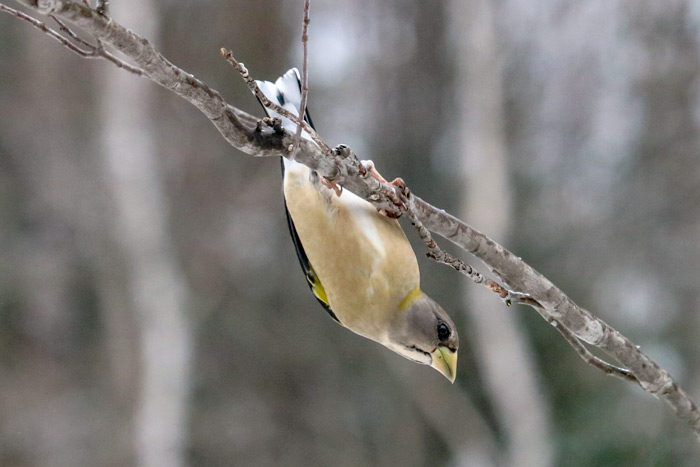
(f/5.6, 1/500 second, ISO 2500, 55-250 @ 55mm)
Evening Grosbeaks are large finches with very thick, powerful, conical bills. They have massive heads with a thick neck, a full chest, and a relatively short tail and pointed wings.
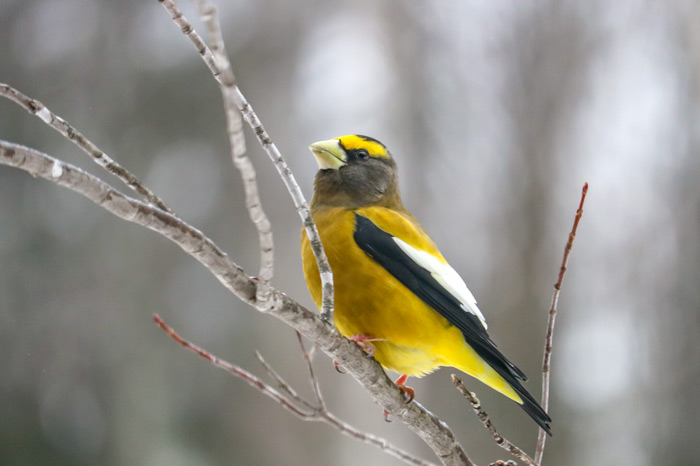
(f/5.6, 1/500 second, ISO 1250, 55-250 @ 55mm)
Adult male evening grosbeaks are yellow and black, with a prominent white patch in the wings. They have dark heads with a bright-yellow stripe over the eye. The bill is pale ivory on adult males.
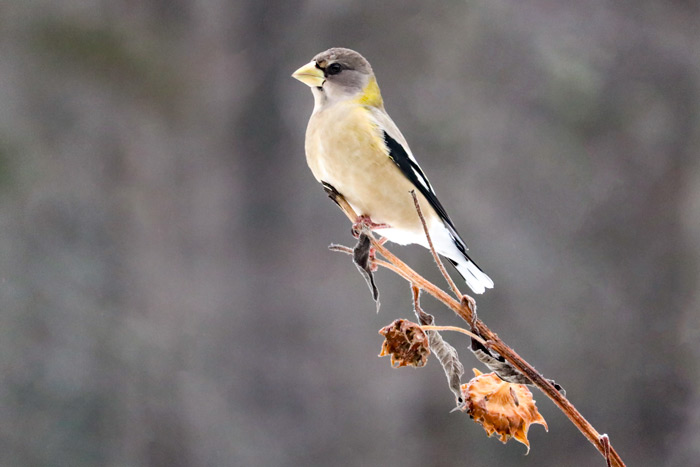
(f/5.6, 1/500 second, ISO 2500, 55-250 @ 55mm)
Female and immature evening grosbeaks are mostly olive-brown, with greyer underparts. The wings have white patches, with white-and-black and a greenish-yellow tinge to the neck and flanks. The beak is greenish-yellow.
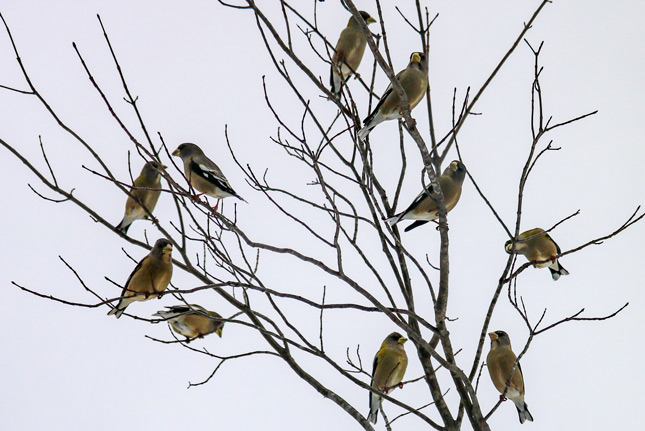
(f/4.5, 1/500 second, ISO 500, 55-250 @ 55mm)
Evening Grosbeaks are social birds that are often found in flocks, especially in winter.
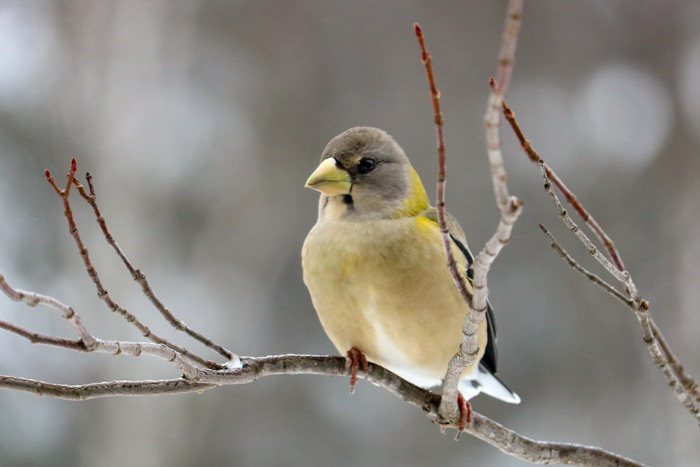
(f/5.6, 1/320 second, ISO 1000, 55-250 @ 55mm)
The habitat of the evening grosbeak includes conifer forests and in winter, box elders, maples, and fruiting shrubs. During migration and winter, these birds can be found in deciduous groves in woodlands and semi-open country.
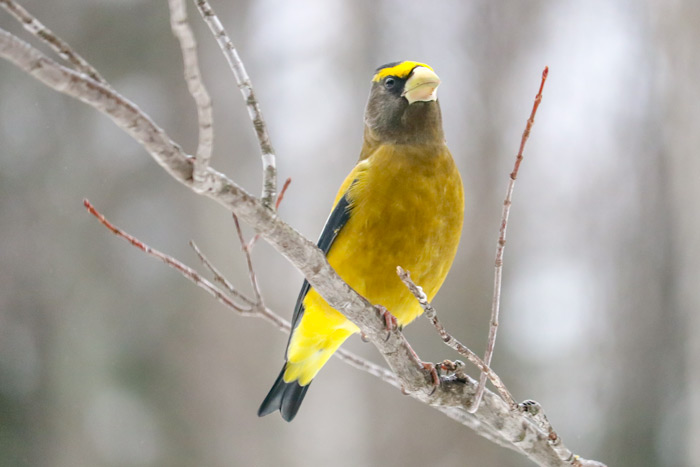
(f/5.6, 1/500 second, ISO 2000, 55-250 @ 55mm)
You can find evening grosbeaks foraging mostly in trees and shrubs and sometimes on the ground. Except when nesting, these birds usually forage in flocks.
Evening grosbeaks mostly feed on seeds, some berries, and insects. Seeds make up the majority of their diets. The huge bill of these grosbeaks allows them to crack large seeds with ease. This includes the seeds of box elder, ash, maple, locust, and other trees. They also feed on the buds of deciduous trees, berries, small fruits, and weed seeds. They will feed on oozing maple sap and some insects during the summer. They will also eat fine gravel for minerals and salts.
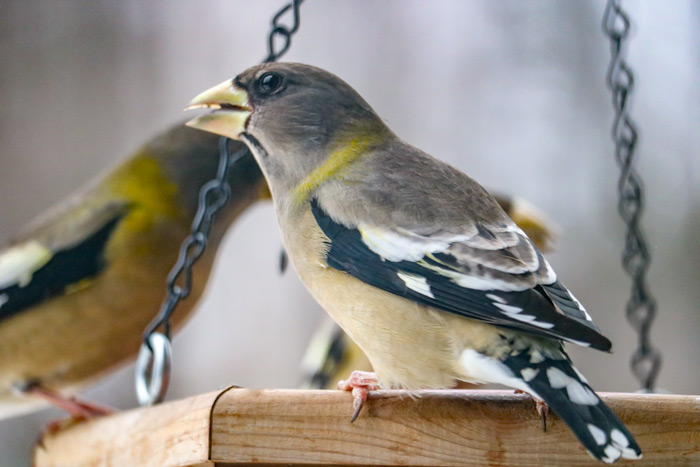
(f/5.6, 1/230 second, ISO 1600, 55-250 @ 55mm)
At feeders, evening grosbeaks are quite fond of sunflower seeds.
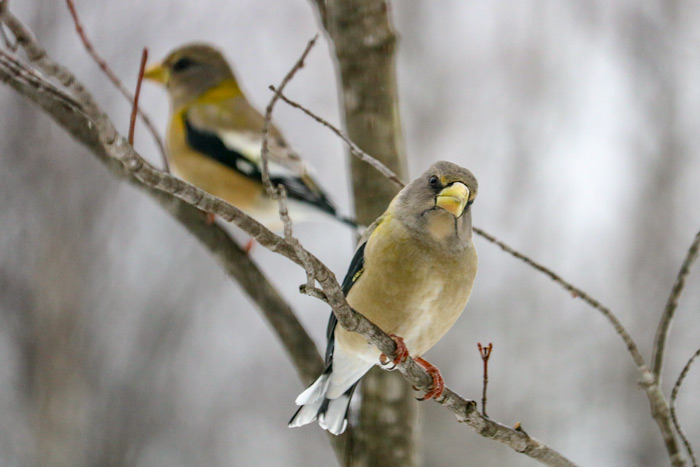
(f/5.6, 1/500 second, ISO 1000, 55-250 @ 55mm)
During courtship, the male evening grosbeak “dances” with its head and tail raised, wings drooped and vibrating, as he swivels back and forth. The male frequently feeds the female. In other courtship displays, both members of a pair may bow alternately. These birds breed in coniferous and mixed forests, such as spruce and fir in northern forests and pines in the western mountains.
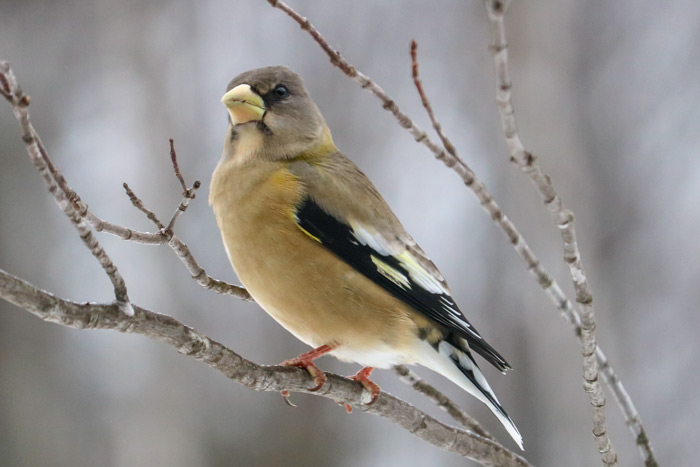
(f/6.3, 1/500 second, ISO 1600, 55-250 @ 55mm)
Nesting sites of the evening grosbeak are usually on a horizontal branch, far from the trunk, or in a vertical fork of a tree. The nest is built by the female and is constructed as a loosely made-up cup of twigs, lined with fine grass, moss, rootlets, and pine needles.
There are 2-4 eggs, sometimes 2-5. The eggs are pale blue to blue-green, blotched with brown, gray, and purple. The eggs are incubated by the female only, for about 11-14 days. The male feeds the female during the incubation period. The young leave the nest about 2 weeks after hatching and there are 1 or 2 broods per year. Both parents feed the nestlings. Young will leave the nest about 2 weeks after hatching
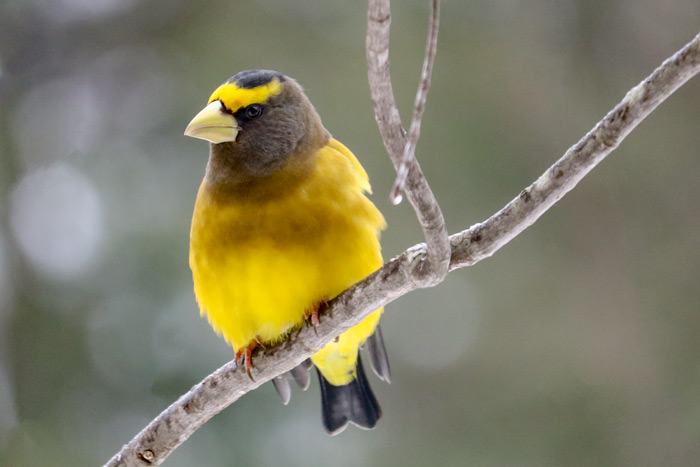
(f/5.6, 1/320 second, ISO 2000, 55-250 @ 55mm)
The evening grosbeak is an irregular migrant. When cone crops in northern coniferous forests are poor, these birds will “irrupt” in fall and spend winters far south of their normal range. These irruptions formerly happened every 2–3 years in the Eastern United States, but have become less frequent, especially in the East, since the 1980s. Western subspecies will migrate to lower elevations for the winter.
This year, it is expected that the evening grosbeak will have a moderate flight south into southern Ontario and the northern states because both conifer and deciduous seed crops have been low in the Northeast. If you would like a chance at observing these beautiful birds, make sure to keep your feeders filled with black sunflower seeds.
Resources used for this post:
allaboutbirds.org, audubon.org & The Sibley Guide to Birds
Leave a Reply